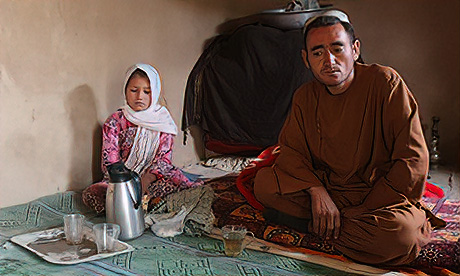Parwana Malik, a 9-year-old girl with dark eyes and rosy cheeks, giggles with her friends as they play jump rope in a dusty clearing.
But Parwana’s laughter disappears as she returns home, a small hut with dirt walls, where she’s reminded of her fate: she’s being sold to a stranger as a child bride.
The man who wants to buy Parwana says he’s 55, but to her, he’s “an old man” with white eyebrows and a thick white beard, she told CNN on October 22. She worries he will beat her and force her to work in his house.
But her parents say they have no choice.
For four years, her family have lived in an Afghan displacement camp in northwestern Badghis province, surviving on humanitarian aid and menial work earning a few dollars a day. But life has only gotten harder since the Taliban took power in Afghanistan on August 15.
As international aid dries up and the country’s economy collapses, they’re unable to afford basic necessities like food. Her father already sold her 12-year-old sister several months ago.
Parwana is one of many young Afghan girls sold into marriage as the country’s humanitarian crisis deepens. Hunger has pushed some families to make heartbreaking decisions, especially as the brutal winter approaches.
The parents gave CNN full access and permission to speak to the children and show their faces because they say they cannot change the practice themselves.
“Day by day, the numbers are increasing of families selling their children,” said Mohammad Naiem Nazem, a human rights activist in Badghis. “Lack of food, lack of work, the families feel they have to do this.”
Abdul Malik, Parwana’s father, can’t sleep at night. Ahead of the sale, he told CNN he’s “broken” with guilt, shame and worry.
He had tried to avoid selling her — he travelled to the provincial capital city Qala-e-Naw to search unsuccessfully for work, even borrowing “lots of money” from relatives, and his wife resorted to begging other camp residents for food.
But he felt he had no choice if he wants to feed his family.
“We are eight family members,” he told CNN. “I have to sell to keep other family members alive.”
The money from Parwana’s sale will only sustain the family for a few months before Malik has to find another solution, he said.
Parwana said she hoped to change her parents’ minds — she had dreams of becoming a teacher and didn’t want to give up her education. But her pleas were futile.
On October 24, Qorban, the buyer, who only has one name, arrived at her home and handed 200,000 Afghanis (about $2,200) in the form of sheep, land and cash to Parwana’s father.
Qorban didn’t describe the sale as a marriage, saying he already had a wife who would look after Parwana as if she were one of their own children.
“I will have to sell another daughter if my financial situation doesn’t improve — probably the 2-year-old”
“(Parwana) was cheap, and her father was very poor and he needs money,” Qorban said.
“She will be working in my home. I won’t beat her. I will treat her like a family member. I will be kind.”
Parwana, dressed in a black head covering with a colourful floral garland around her neck, hid her face and whimpered as her weeping father told Qorban: “This is your bride. Please take care of her — you are responsible for her now, please don’t beat her.”
Qorban agreed, then gripped Parwana’s arm and led her out the door. As they left, her father watching by the doorway, Parwana dug her feet into the dirt and tried to pull away — but it was no use. She was dragged to the waiting car, which slowly pulled away.
Since the Taliban’s takeover, stories like Parwana’s have been on the rise.
Though marrying off children under 15 is illegal nationwide, it has been commonly practised for years, especially in more rural parts of Afghanistan. And it has only spread since August, driven by widespread hunger and desperation.
More than half the population is facing acute food insecurity, according to a United Nations report released this week. And more than 3 million children under age 5 face acute malnutrition in the coming months. All the while, food prices are soaring, banks are running out of money and workers are going unpaid. Continue reading
